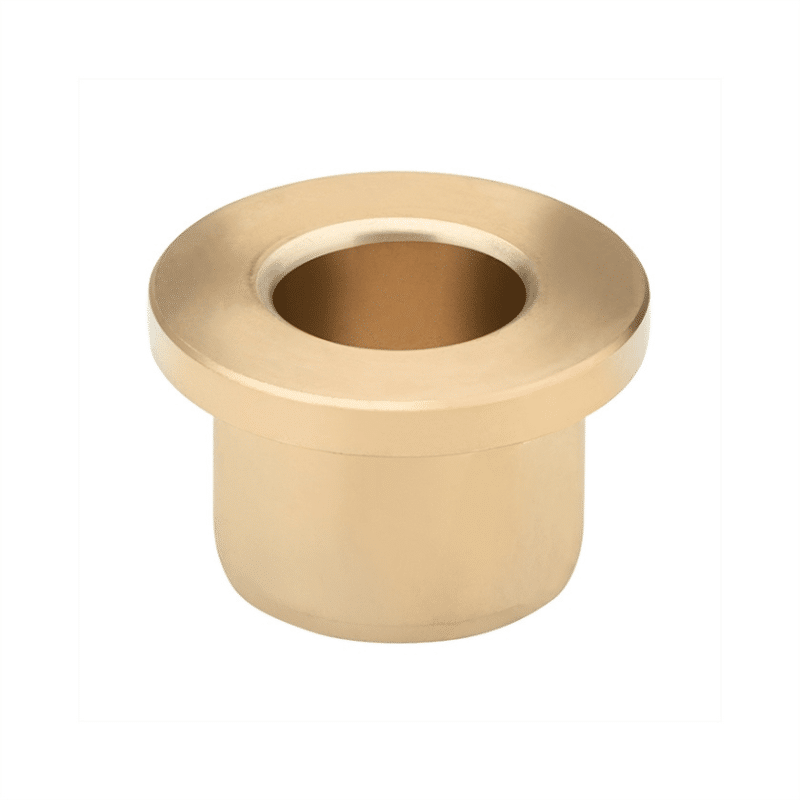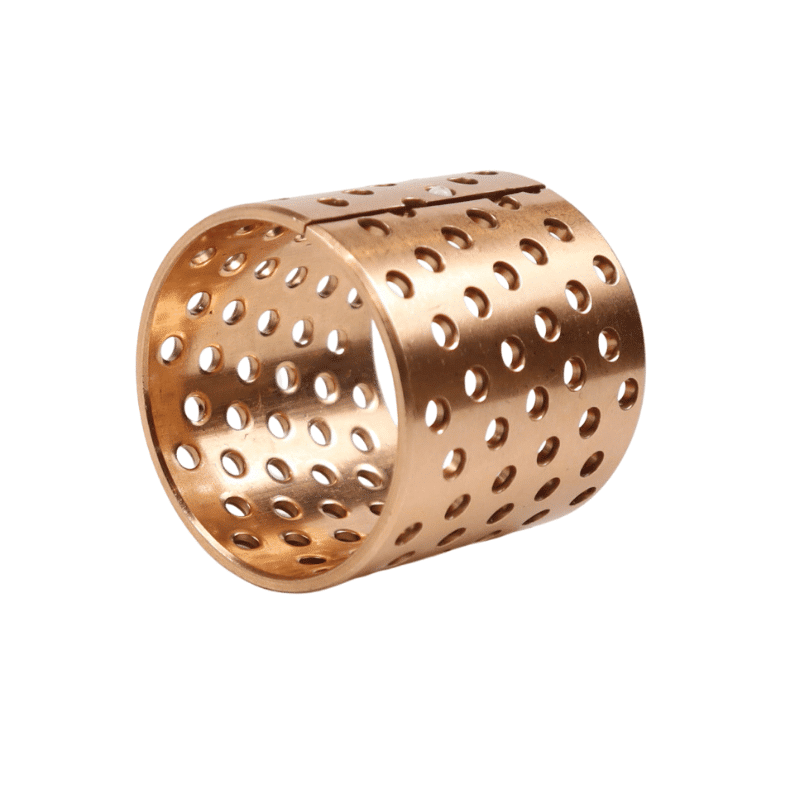AISI 316 BUSH
AISI 316 BUSH
Say goodbye to the hassle of frequent lubrication maintenance. Our self-lubricating technology ensures smooth operation and reduces wear and tear, extending the lifespan of your equipment. Experience uninterrupted productivity and cost savings as you bid farewell to the need for messy lubricants and time-consuming upkeep.
Manufacturing on Demand, alternative solutions
AISI 316 BUSH
Bushing components crafted from AISI 316 stainless steel and enhanced with a PTFE (Polytetrafluoroethylene) coating are designed for superior performance in multiple industrial settings. This integration combines the robust, corrosion-resistant qualities of AISI 316 stainless steel with PTFE’s outstanding low friction, non-stick characteristics, and resistance to chemicals.
Key Benefits of AISI 316 Stainless Steel: AISI 316 stainless steel is celebrated for its exceptional resistance to corrosion, particularly against chlorides and various industrial chemicals, making it a prime choice for demanding environments in the chemical, marine, and pharmaceutical sectors. The presence of molybdenum in AISI 316 boosts its ability to withstand pitting and crevice corrosion, setting it apart from other stainless steel variants.
Perks of PTFE Coating: PTFE offers benefits that enhance the functionality of AISI 316 bushings, including:
- Non-Stick Characteristics: PTFE coatings ensure excellent non-stick properties, simplifying cleaning processes and reducing the chances of material sticking.
- Reduced Friction: With its low friction coefficient, PTFE lessens wear and energy usage in moving components, thus prolonging the bushing’s lifespan.
- Temperature Endurance: PTFE coatings can endure a broad spectrum of temperatures, from the extreme cold up to +260°C, and temporarily up to +290°C.
- Chemical Endurance: Being resistant to most chemicals, PTFE bolsters the bushing’s performance in harsh chemical conditions.
- Enhanced Corrosion Resistance: Coupled with AISI 316 stainless steel, PTFE coatings amplify the bushing’s resistance to corrosion.
Bushing Body: AISI 316 Internal: C20 + C94100 + Pb Coat
The PTFE bush body described in the query is composed of multiple materials, each selected for its specific properties to enhance the performance of the bushing in its application. Let’s break down the components:
AISI 316 Stainless Steel
AISI 316 stainless steel is known for its excellent corrosion resistance, especially against chlorides and other industrial solvents. This makes it an ideal choice for applications in harsh environments where corrosion resistance is paramount. It also has good mechanical properties and welding characteristics. The use of AISI 316 stainless steel as the body material ensures the bushing’s durability and resistance to corrosive elements.
Internal Composition: C20 + C94100 + Pb Coat
- C20 Steel: This is a mild steel with good ductility and weldability. It’s commonly used in general engineering applications. In the context of a PTFE bush, C20 could serve as a base material providing structural integrity.
- C94100 High Leaded Tin Bronze: This alloy is part of the high-leaded tin bronze family, characterized by its excellent machinability, good thermal conductivity, and inherent lubricity due to the lead content. The lead content in C94100 ranges between 18% to 22%, which enhances its compatibility with the lubrication boundary, making it ideal for bearing applications where there might be a loss of the lubrication boundary. It performs well in environments where foreign matter such as dirt may be present, as it can envelop such matter, protecting the wear surface of a coupled part.
- Pb Coat: The presence of a lead (Pb) coat further enhances the bushing’s lubricity. Lead has a low shear strength and can form a lubricating layer between the bushing and the mating surface, reducing friction and wear. This is particularly beneficial in applications where additional lubrication is either not possible or not desired.
AISI 316 stainless steel
The combination of AISI 316 stainless steel for the body, with an internal composition of C20 steel and C94100 high leaded tin bronze, plus a lead coat, creates a PTFE bush that is robust, corrosion-resistant, and has excellent lubricity. This makes it suitable for a wide range of industrial applications, especially those involving high loads and harsh environmental conditions. The materials chosen for this PTFE bush ensure a balance between mechanical strength, corrosion resistance, and reduced friction, leading to enhanced performance and longevity of the bushing in its application.
Introduction AISI 316 stainless steel stands out as a prominent austenitic stainless steel variety, trailing only behind AISI 304 in usage, renowned for its exceptional resistance to corrosion.
Composition Its composition includes essential alloying elements such as chromium (16-18%), nickel (10-12%), and molybdenum (2-3%), along with minor quantities of silicon, phosphorus, and sulfur.
Corrosion Resistance The presence of molybdenum in AISI 316 bolsters its corrosion resistance, offering superior protection against chlorides and aggressive substances like sulfuric acid compared to its 304 counterpart.
AISI 316 stainless steel, also recognized as SAE/ANSI/AISI 316, is celebrated for its robustness and resistance to corrosion, making it a favored material in various sectors, especially where exposure to corrosive agents is prevalent. Its molybdenum content, which can reach up to 3%, sets it apart from AISI 304, enhancing its resistance to chloride and sulfide attack. This quality renders it ideal for use in maritime settings and challenging industrial conditions.
Chemical Composition and Properties AISI 316’s austenitic structure comprises predominantly iron (68.5%), with notable amounts of chromium (16.25%), nickel (11.5%), and molybdenum (2.5%), supplemented with manganese, silicon, nitrogen, carbon, phosphorus, and sulfur. This composition affords it superior corrosion resistance, elevated temperature tensile strength, and resilience against acidic solutions like nitric acid.
Applications The alloy’s excellent corrosion resistance has led to its widespread use in the pharmaceutical sector, food service, medical devices, coastal areas, and settings with high saline exposure. It is also preferred in breweries and environments with significant exposure to alkalis and acids.
Fabrication and Machining AISI 316 stainless steel is amenable to standard fusion forming, welding, and machining. It is annealed at high temperatures and swiftly cooled to maintain its corrosion resistance. However, it is not susceptible to hardening via heat treatment.
Mechanical and Physical Properties With a density of 8.00 g/cm³ and a melting point between 1380-1400°C, AISI 316 also exhibits a modulus of elasticity of 193 GPa and specific thermal properties. Its mechanical strengths, such as tensile and yield strengths, vary with the form and are complemented by notable elongation rates.
Conclusion The superior corrosion resistance, mechanical strength, and adaptability of AISI 316 stainless steel render it an optimal material for a broad array of applications, from maritime settings to medical instruments. Its durability in corrosive conditions and manufacturability underscore its widespread industrial appeal.
The provided material details describe a composite bearing material used in scenarios where low friction and robust wear resistance are essential. Here’s a breakdown of the material layers:
- PTFE with Lead (0.01-0.03mm): This layer comprises polytetrafluoroethylene (PTFE) enhanced with lead, ranging in thickness from 0.01 to 0.03 millimeters. PTFE is celebrated for its minimal friction and chemical resistance, while the lead enhancement boosts its wear resistance.
- Porous Bronze (0.01-0.03mm): This refers to a porous bronze layer, with a thickness similar to the PTFE layer. It’s commonly employed in bearings as an intermediate layer to retain lubricants, which helps decrease friction during operation.
- Steel Backing (ST52 0.4 – 2.2mm): The bearing’s structural support is provided by a steel backing made from ST52 structural steel, with thicknesses ranging from 0.4 to 2.2 millimeters.
- Tin or Copper Plating (0.005-0.008mm): The bearing features a thin coating of tin or copper, with thicknesses between 0.005 and 0.008 millimeters, which can enhance corrosion resistance and wear properties.
Users seeking alternatives to Glacier Bush DU bearings, known for their performance under various conditions and their self-lubricating, maintenance-free nature, might consider other PTFE-lined, metal-backed bushing options available in the market. These alternatives, similar to the Glacier Bush DU bearings, come in various sizes and shapes and are designed for high-performance applications. Designated metal-polymer aisi 316 steel backed bush and bearings.
When selecting alternatives, it’s crucial to ensure that the material properties, dimensions, and performance characteristics align with the original application’s requirements. The chosen bearings should offer maintenance-free usage, excellent frictional properties, high load capacity, suitability for high temperatures, and compatibility with high sliding velocities, mirroring the advantages of Glacier Bush DU bearings.
Diverse Applications: The AISI 316 stainless steel and PTFE coating amalgamation renders these bushings versatile, suitable for various sectors, including:
- Chemical Industry: Their superior resistance to chemicals and corrosion is ideal for chemical processing applications.
- Food Processing: PTFE’s non-stick nature is advantageous in food processing and packaging, ensuring cleanliness and sanitation.
- Aerospace and Automotive: Essential in these fields, the low friction and high-temperature resilience of the bushings are crucial for reliability and efficiency.
- Pharmaceuticals: The inertness of PTFE-coated AISI 316 bushings guarantees no interaction with pharmaceutical products, preserving purity and preventing contamination.
Conclusion: PTFE-coated AISI 316 bushings are a robust choice for scenarios demanding low friction, high corrosion resistance, and enduring performance in tough conditions. Their broad range of advantageous features makes them applicable in various industries, from chemical processing to food production, and more.
Your expert in self-lubricating Bearing
and Bronze alloys – serving globally
Brand replacement products and functionally equivalent parts, alternative solutions
Manufactures flange bronze bearings, service & maintenance companies to meet the exacting specifications required in a wide range of industrial applications.
Machined bronze bushing that meet the exacting requirements & specifications supplied by our clients. Spherical bearings, spindles, semi-spheres and supports that we have manufactured.
You will find to follow a selection of self lubricating bronze bearing material CuSn7Zn4Pb7, CuSn12, CuAl10Fe5Ni5,
CuZn25Al5Mn4Fe3
Alternative solution,We offer an outsourced machining service for bronze bushes, manufacturing precise parts to the designs supplied to us by our clients.
Selection of other composite bushing material of self lubricating bearing that we have manufactured.
Wrapped Bronze Sleeve Bearing, Are you interested in our products?
Manufacturer of bimetal and steel bronze bushing parts according to client’s drawing.










